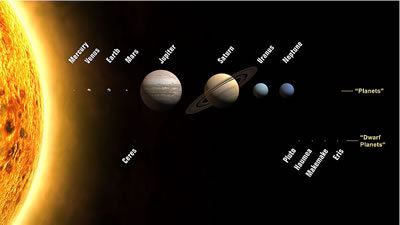
The Solar System consists of the Sun and all of the objects that orbit it.
These include the Earth, its Moon, the other planets and their moons, dwarf planets, asteroids and comets.
The planets of the Solar System, in order of their distance from the Sun, are Mercury, Venus, Earth, Mars, Jupiter, Saturn, Uranus and Neptune.
For a long time, astronomers said that Pluto was a planet. However, they now consider it a dwarf planet, along with at least four other bodies - Ceres, Eris, Haumea and Makemake.
Mercury, Venus, Earth and Mars, the four planets closest to the Sun, are called terrestrial planets because they are similar to the Earth, consisting mostly of metal and rock.
Jupiter, Saturn, Uranus and Neptune are known as gas giants, because they consist mostly of the hydrogen and helium and are much more massive than the terrestrial planets.
There is a large asteroid belt between Mars and Jupiter.
The dwarf planet Ceres lies within this asteroid belt.
The area of the Solar System that lies beyond Neptune is known as the Trans-Neptunian Region. Most Trans-Neptunian objects are relatively small and made up of ice and rock.
Kuiper Belt
The Kuiper Belt, named after the Dutch-American astronomer Gerard Kuiper, extends beyond the orbit of Neptune.
It is about 55 Astronomical Units (AU - the distance from the Earth to the Sun) from the Sun.
Objects in the Kuiper Belt are composed mostly of frozen volatiles, substances that would be liquid or gas on Earth, such as water, ammonia and methane.
There are over a thousand known Kuiper Belt objects.
The dwarf planets Pluto, Eris, Makemake and Haumea lie in the Kuiper Belt.
Oort Cloud
Astronomers believe that there is a spherical cloud of icy objects between one and two light years from the Sun. They call this cloud the Oort Cloud, after Dutch astronomer Jan Hendrik Oort.
Some comets may originate in the Oort Cloud.
Moons
Mercury and Venus have no natural satellites, or moons. The Earth has one and Mars has two.
Jupiter has 66 known moons. Saturn has at least 62 moons. Uranus has 27 known moons and Neptune, at least 15.
Of the dwarf planets, Pluto has five known moons and Haumea, two.
The Earth’s Moon
Of all the planets in the Solar System with moons, the Earth has the largest moon relative to its own size. The Earth’s moon has a diameter of 2,160 miles, a little more than one fourth the diameter of the Earth itself.
Only one other moon in the Solar System is larger relative to the size of the body that it orbits. This is Charon, which orbits a dwarf planet, Pluto, rather than a planet.
Our moon, “The Moon,” is about 240,000 miles away, so close that you can see light and dark areas on its surface with your naked eyes.
Many people think these light and dark regions resemble a face. Legends about a Man in the Moon (or Woman on the Moon) have existed for a long time.
Different cultures on Earth have different explanations for these patterns of light and dark. For example, the Chinese have a myth about a rabbit that lives on the Moon.
The way that the Moon seems to change shape has also been the source of many legends. Storytellers throughout the world have found different ways to explain the Moon’s changing appearance.
In fact, the phases of the Moon are caused by the movement of the Moon around the Earth and the changing amounts of sunlight that we can see reflected from the Moon’s surface.
The Earth’s tides, which play an important role in human culture and have a profound effect on all life on Earth, are caused by the gravitational pull of the Moon as well as by the Sun’s gravity and the rotation of the Earth.
Water on the Moon
When Galileo looked at the Moon through his telescope, he thought the dark areas he saw were bodies of water, and he named them maria, which is the Latin word for "seas".
We now know that the maria are not seas at all, but dark plains of basalt - the remnants of volcanic eruptions.
For a long time, scientists believed that the Moon had no water at all.
Because the Moon has no atmosphere, liquid water cannot exist there because it would immediately evaporate.
However, in the 1990s, lunar spacecraft found large amounts of hydrogen near the Moon’s poles. Astronomers began to suspect that water might exist on the Moon in the form of ice.
In 2009, Indian’s Chandrayan-1 spacecraft found water in the Moon’s soil. That same year, NASA intentionally crashed its Lunar Crater Observation and Sensing Satellite (LCROSS) into a crater on the Moon. The debris that was created contained water.
